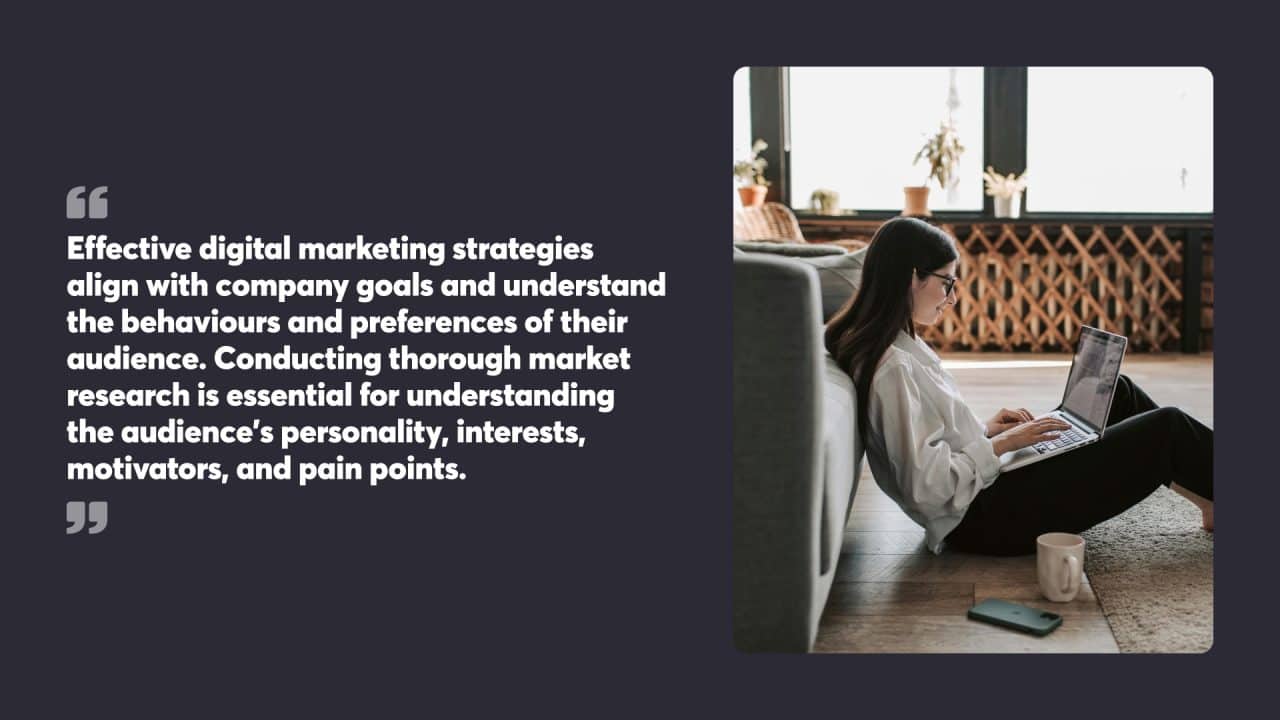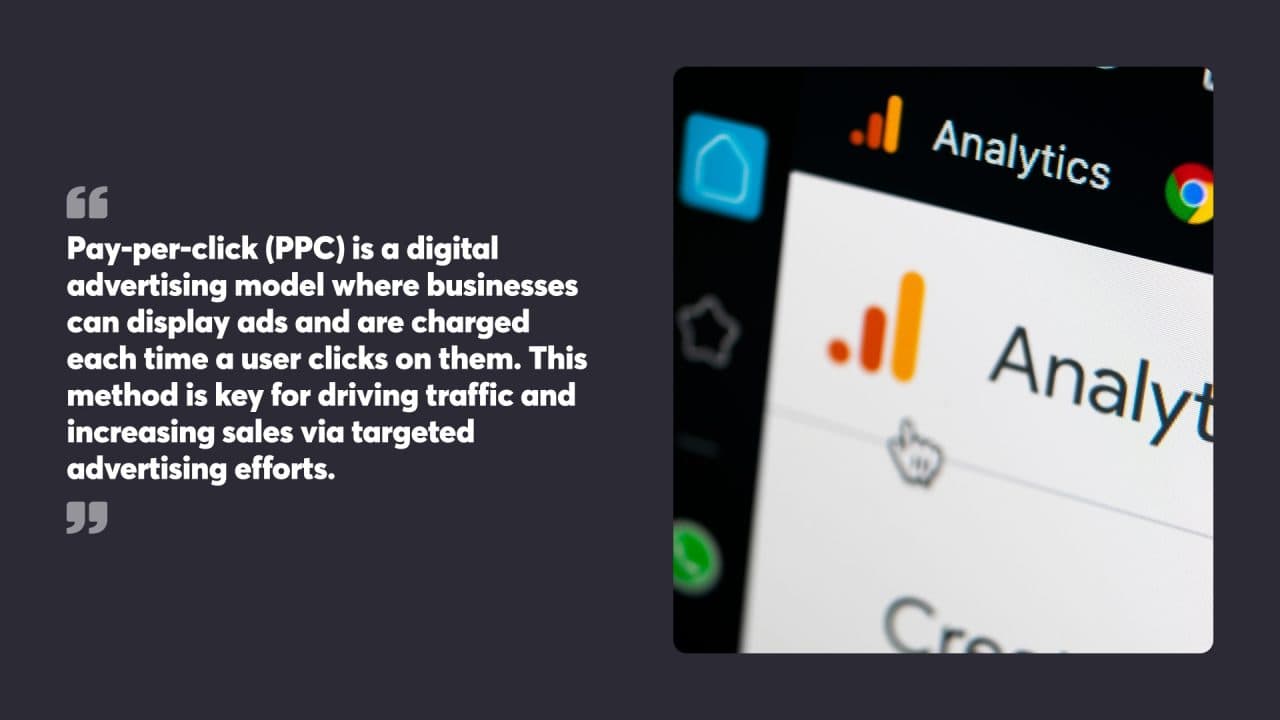
Digital marketing encompasses a wide range of online marketing activities aimed at reaching and engaging with consumers online. It has become an essential part of a company’s overall marketing strategy, utilising methods such as search engine optimisation (SEO), pay-per-click (PPC) advertising, social media marketing, email marketing, and more. These techniques help businesses connect with their audience where they spend a considerable amount of time: online.
Conducting thorough market research is essential for truly understanding the audience’s personality, interests, motivators, and pain points, which helps in creating an effective buyer persona for digital marketing.
A comprehensive digital marketing strategy allows companies to define their target audience, understand their preferences, and create tailored content that resonates with them. Businesses utilise various digital channels, such as search engines, social media platforms, email, and mobile applications, to promote their products and services effectively. With the tools provided by digital marketing, companies can evaluate their marketing efforts in real time, adjust their strategies as needed, and improve their conversion rates and lead quality.
Key Takeaways
- Holistic Channel Integration: Digital marketing effectively integrates diverse online channels—such as SEO, PPC, social media, and email marketing—to engage consumers where they spend a significant amount of time. This multifaceted approach ensures a comprehensive strategy that maximises reach and engagement.
- Data-Driven Strategy Adaptation: Real-time analytics and performance metrics are crucial for adapting digital marketing strategies. By continuously monitoring and analysing campaign data, businesses can refine their tactics to enhance conversion rates and improve lead quality, ensuring that marketing efforts remain effective and aligned with business goals.
- Audience-Centric Content Creation: Understanding and defining the target audience is fundamental to digital marketing success. By leveraging detailed audience profiles and preferences, businesses can create tailored content that resonates with their audience, fostering meaningful interactions and driving higher engagement and loyalty.

Table of Contents
Developing a Digital Marketing Strategy
Effective digital marketing strategies align with company goals and understand the behaviours and preferences of their audience. Conducting thorough market research is essential for understanding the audience’s personality, interests, motivators, and pain points. They select the most suitable online platforms to engage with customers and measure the success of their efforts.
Understanding Your Target Audience
Before a business launches any marketing campaign, it is essential to identify who the audience is. Detailed audience profiles, which outline demographics, interests, and online behaviours, provide direction for customising content and messaging. Businesses gather data through social media analytics, surveys, and customer feedback to form a clear picture of their target market. This understanding leads to more meaningful interactions and increases the likelihood of reaching prospective customers.
Setting Achievable Goals
Clear objectives set a direction for the company’s digital marketing efforts. These goals, whether related to increasing brand awareness or boosting sales, should be specific, measurable, achievable, relevant, and time-bound (SMART). For instance, a business might aim to increase website traffic by 30% in six months using SEO and content marketing strategies. Goals should be evaluated regularly to ensure they remain aligned with the changing business environment.
Evaluating Online Platforms
The selection of online platforms is critical in reaching the intended audience. Each platform has its strengths, whether it’s social media for building brand community, search engines for attracting organic traffic, or email marketing for nurturing leads. The chosen platforms should match the preferences of the target audience and support the overall business objectives. Companies also consider the resource allocation for managing these platforms, which includes content creation and analysis of performance metrics.

Search Engine Optimisation
Search Engine Optimisation (SEO) is a vital part of an online marketing strategy, playing a crucial role in improving website visibility, reaching new customers, and optimising content for relevant keywords.
Keyword Research Techniques
Effective SEO begins with identifying the appropriate keywords that potential customers use to find products or services online. Keyword research involves analysing search terms that are both relevant to the business and have a reasonable volume of searches. The goal is to strike a balance between highly competitive keywords and those that are too obscure. Utilising tools like Google Keyword Planner can aid in discovering phrases that align with the business objectives.
- Start by listing core topics relevant to the business.
- Use keyword research tools to expand the list with related search terms.
- Analyse search volume and competition to select the most beneficial keywords.
On-Site SEO Best Practices
A well-optimised website contributes significantly to its search engine ranking. On-site SEO involves optimising individual web pages to rank higher and earn more relevant traffic. This process includes optimising both the content and the HTML source code of a page.
- Include relevant keywords in titles, headings, and meta descriptions.
- Ensure that the website’s structure allows search engines to crawl and index content effectively.
- Improve user experience by enhancing site speed, mobile-friendliness, and navigation.
Building Backlinks for Improved Ranking
Backlinks, links from other websites to your own, are critical for improving a site’s visibility. Each backlink serves as a vote of confidence from one site to another, indicating to search engines that the content is valuable and credible.
- Create high-quality, shareable content that naturally encourages linking.
- Engage in guest blogging on reputable platforms to gain backlinks.
- Reach out to industry influencers to share or link to your site’s content.

Pay-Per-Click Advertising
Pay-per-click (PPC) is a digital advertising model where businesses can display ads and are charged each time a user clicks on them. This method is key for driving traffic and increasing sales via targeted advertising efforts.
Creating Effective Google Ads Campaigns
When setting up campaigns on Google Ads, defining clear objectives is essential. Advertisers should first research relevant keywords their potential customers are using and structure their campaigns to align with these terms. Google Ads allows for different types of keyword matching options—broad match, phrase match, and exact match—to control how aggressively or selectively an ad may appear against user queries.
Campaign Structure:
- Organise campaigns into ad groups with a common theme.
- For each ad group, write compelling ad copy and select appropriate keywords.
- Choose matching options that balance reach and relevance.
Budgeting and Bidding:
- Determine a daily budget that aligns with advertising goals.
- Implement bidding strategies that focus on achieving specific objectives, like maximising clicks or conversions.
Targeting and Scheduling:
- Target ads to specific locations, languages, and devices.
- Use ad schedules to display ads during optimal times.
Optimising Ads for Conversion
Optimisation is the process of enhancing PPC ads to increase the likelihood of conversion— meaning turning traffic into valuable actions, such as sales or leads. Ad copy should be directly related to the keywords being targeted, and the messaging should be clear and direct, effectively communicating the value proposition.
Conversion Tracking:
- Set up conversion tracking to measure the effectiveness of ads.
- Use the data collected to make informed decisions about ad optimisation.
Landing Page Alignment:
- The landing page should be consistent with the ad in terms of content and design.
- It must provide a straightforward, compelling call to action.
A/B Testing:
- Routinely test different elements of ads and landing pages.
- Compare performance to identify which variations lead to the best conversion rates.
By carefully managing campaigns and continually refining ads and landing pages, businesses can effectively increase the return on their PPC investment.

Social Media Marketing
Social media marketing uses platforms like Facebook, Twitter, and Instagram to connect with consumers, enhance brand presence, and drive website traffic. This form of marketing involves crafting shareable content and advertorials, as well as fostering direct engagement with customers.
Harnessing Different Social Media Platforms
Each social media platform serves distinct market segments and offers various tools for marketers. Facebook appeals widely due to its vast user base, enabling brands to reach a diverse audience. Instagram, with its visual focus, is ideal for products that benefit from strong imagery and storytelling. LinkedIn’s professional network supports B2B marketing strategies effectively. Brands should select platforms that align with their target demographics and marketing objectives.
Creating Compelling Social Media Posts
Effective social media posts are concise, visually appealing, and aligned with the brand’s voice. High-quality images or videos can increase viewer engagement. Posts should provide value, such as tips, insights, or compelling narratives that reflect the brand’s ethos. Social media algorithms favour content that generates interaction, so including calls to action (CTAs) can encourage consumers to like, comment, or share.
Building Relationships and Fostering Engagement
Social media excels in building relationships between brands and consumers. Brands should actively respond to comments and messages to foster a sense of community. Regularly engaging with followers can create loyal customers and brand advocates. Share user-generated content to show appreciation and reinforce community ties. Analysing engagement data can guide future strategies to maintain a robust online presence.
Email Marketing
Email marketing remains a steadfast approach in digital marketing strategies, providing businesses with direct lines of communication with their customers. Its effectiveness lies in the ability to dispatch targeted and personalised content to segmented audiences, fostering higher engagement and conversion rates.
Segmenting Audiences for Personalised Campaigns
Segmenting audiences allows for the creation of focused campaigns that resonate with specific customer groups. Through the analysis of customer data, email marketing can serve highly personalised content, based on demographics, purchase history, or engagement levels. Segmentation strategies benefit both customers, who receive relevant information and offers, and businesses, which see improved open rates and campaign performance.
- Demographic Segmentation: Divides the target audience based on age, gender, occupation, etc.
- Behavioural Segmentation: Focuses on customers’ purchasing behaviour and engagement.
- Geographic Segmentation: Targets customers based on their location.
- Psychographic Segmentation: Separates customers by their lifestyles, interests, or values.
Designing Email Campaigns for Maximum Impact
Email campaigns must seize attention amidst a flood of inbox content. This requires well-thought-out designs, combining aesthetic appeal with clear messaging and calls to action. The design should reflect the brand’s identity and values, while also being responsive across devices.
- Subject Lines: Crucial for open rates; should be compelling and concise.
- Visual Design: Use of brand colours, logos, and high-quality images to convey messages effectively.
- Content: Clear and concise copy with a strong call to action.
- Responsive Design: Emails should display well on various screens and devices.
Analysing Email Campaign Performance
Post-campaign analysis is vital to refine marketing efforts. Key performance indicators (KPIs) shed light on what works and what doesn’t, informing future strategies. Businesses should closely monitor open rates, click-through rates, and conversion rates, along with more nuanced metrics like time spent reading the email and interaction with embedded media.
- Open Rates: The percentage of recipients who opened the email.
- Click-Through Rates (CTR): The percentage of readers clicking on links within the email.
- Conversion Rates: The percentage of recipients taking the desired action after clicking through.
- Engagement Time: How long recipients spend interacting with the email content.

Influencer Marketing
Influencer marketing is a strategy where brands connect with influencers to engage with new audiences and encourage consumer participation. Influencer marketing involves working with individuals within your industry who have gained a following and are seen as experts to get them to share your content and recommend your products or services. It leverages influencers’ reach and credibility to effectively engage potential customers.
Identifying the Right Influencers
The process begins by identifying influencers who align with a brand’s values and have access to the desired audience demographic. Key considerations include:
- Audience demographic: Analyse the age, location, and interests of the influencer’s audience.
- Engagement rate: Review the influencer’s interaction levels through likes, comments, and shares.
- Content quality: Assess the quality and relevance of the influencer’s content to the brand’s message.
- Previous partnerships: Evaluate past collaborations for consistency and success.
By selecting the right influencers, brands can engage with audiences more authentically compared to traditional advertising methods.
Collaborating with Influencers for Brand Reach
Once the right influencers are identified, developing a clear collaboration strategy is critical. Effective collaborations involve:
- Clear goals: Set specific objectives, whether it’s increasing brand awareness, generating leads, or boosting sales.
- Creative freedom: Allow influencers to use their creativity, which resonates well with their audience.
- Transparent communication: Open dialogue regarding expectations, deliverables, and compensation fosters trust.
- Performance tracking: Utilise metrics to analyse the performance and impact of the influencer partnership.
By applying these practices, influencer marketing can serve as a powerful tool for brands to reach out to new audiences and enhance their market presence.

Video Marketing
Video marketing has become a significant strategy for brands aiming to engage with their audience and increase online traffic. It leverages the persuasive power of visual content to tell compelling stories, highlight product features, and connect with consumers on a personal level.
Producing Engaging Video Content
Successful video marketing begins with the creation of content that captures the attention and interest of viewers. Engaging content often addresses the viewer’s needs, solves problems, or provides value in an entertaining yet informative way. When developing videos, consider the following:
- Audience Research: Understand who the audience is and what they find engaging. Use analytics and feedback to refine video topics and presentation styles.
- Content Quality: High-definition visuals and clear audio are essential. A well-lit, steady shot is more likely to retain viewers than poor-quality footage.
- Storytelling: Incorporate storytelling to make the video more relatable and memorable. Each video should have a coherent narrative that encompasses a beginning, middle, and end.
- Consistency: Posting regular content can help maintain and grow a viewer base. Determine a content schedule that aligns with the ability to produce quality videos without compromising standards.
Promoting Videos Across Digital Channels
Once the video content is produced, promotion across various digital channels can greatly expand its reach and effectiveness. Consider these aspects for effective video promotion:
- SEO for Video: Including relevant keywords in the video title, description, and tags can assist in improving visibility on search engines and video platforms.
- Social Media Platforms: Share and promote videos on platforms where the target audience is most active. Engage with viewers through comments and shares.
- Email Marketing: Integrate videos into email campaigns as this can increase click-through rates and provide additional value to subscribers.
- Paid Advertising: Invest in paid promotion options like in-stream video ads or sponsored posts to reach a larger, targeted audience.
- Analytics: Track video performance across all promotional channels using analytics tools. This data guides future video marketing strategies and optimisation efforts.

Mobile Marketing
Mobile marketing is a strategy that gears marketing efforts towards reaching customers on their mobile devices through various digital channels. By leveraging the intricacies of mobile technology, businesses can connect with consumers in a direct and personal way.
Adapting Strategies for Mobile Devices
Businesses must tailor their marketing strategies to the unique behaviours of mobile users. Mobile devices typically have smaller screens, which means content must be designed for easy reading and interaction. Speed also plays an important role, as mobile websites and advertisements must load quickly to maintain user engagement. Location-based services also offer marketers the opportunity to present offers to customers in the vicinity of their stores or establishments.
Engaging Mobile Users with Apps and SMS
Creating applications or utilising SMS can greatly improve engagement with consumers. Apps give businesses a direct line to their customers, providing them with a platform for interactive and consistent communication. App notifications can be an effective method to alert users about new content or special offers. Similarly, SMS marketing can be a powerful tool owing to the high open rates of text messages. It is a means to distribute coupons, announce sales, or convey important service updates immediately to a consumer’s hand-held device.

Analysing Digital Marketing Efforts
Tools and strategies for assessing and enhancing digital marketing campaigns are essential for businesses to understand how consumers interact with their brand.
Understanding Analytics to Measure Success
Analytic solutions offer insights into consumer behaviour by tracking and interpreting data from digital marketing activities. Key performance indicators (KPIs) form the backbone of this process, providing vital feedback on campaign effectiveness. They might consider metrics such as conversion rates, which reflect the percentage of users who have completed a desired action, or click-through rates (CTR), an indicator of the success of online advertising or email campaigns.
Beyond basic metrics, it’s important to assess customer lifetime value (CLV), which estimates the total revenue a business can expect from a single customer account. Additionally, assessing organic traffic growth offers clues about the efficacy of search engine optimisation (SEO) techniques.
Adapting Strategies Based on Data and Insights
Armed with data, organisations adjust their strategies to reflect what they have learned. A surge in organic traffic might lead to the production of more targeted content, while a reduced email engagement rate could spur changes to the email marketing strategy.
Furthermore, insights drawn from social media analytics can guide adjustments in advertising spend and content creation. This continuous loop of data collection, analysis, and strategy adjustment forms the touchstone of digital marketing excellence. Identifying underperforming areas and reallocating resources to those that show potential maximises both efficiency and the potential for success.
At Chillybin our digital marketing campaigns leverage a strategic mix of SEO, social media, and email marketing to engage your target audience effectively, driving measurable results for your business.
If you have any questions about how digital marketing could work for your business, or how we could help you reach your goals, please contact us today.




